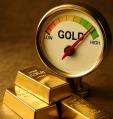Richard Russell on the Markets
Early in the year 2001 twenty-two "expert" Wall Street analysts from Louis Ruykeyser's "Wall Street Week" gave their estimates as to where the Dow would be at the close the year. The estimates ranged from 11,400 to 12,300. But the actual Dow close was 10,021. Not one of the 22 panelists guessed that the Dow would close under 11,000.
Again, early this year the same twenty-two top analysts gave their estimates as to where the Dow would close in 2002. The estimates ranged from 10,750 to 12,100. As of today, the Dow is at 8460. Not one of the 22 experts saw the Dow closing below 10,000.
How can this be? My answer is that none of these analysts is able to recognize change. Although we are in a primary bear market, evidently NONE of these experts understands what this means. Either that or they are so inculcated with the optimism of the last 25 years that they are not able to envision an extended, disastrous bear market.
So let's try to understand the big picture and not make the same mistake that these twenty-two experts made on two consecutive years. First, let me repeat an old adage that applies to the majority of Wall Street analysts --
"When everybody is thinking the same, nobody is thinking."
In order to understand what's going on, we have to understand the BIG PICTURE.
The big picture is that we've just completed the longest (1974 to 1999) bull market in history, and arguably the greatest and most speculative bull market in history (Dow 577 to Dow 11200).
The bear market that has followed this great bull market has been in force for three years (1999 to 2002). The Dow, so far, has lost 37.8% of its peak price.
Almost every bear market in history has seen the Dow give back at least half of its gains. On this basis alone, the bear market hardly seems to have been completed.
Furthermore, every major bear markets has declined to the point where blue chip stocks represent "great values." With the Dow now selling at better than 20 times earnings and providing a dividend yield below 2% it can hardly be argued that stocks are now selling at great values.
At the bull market's peak and its "throw-over" during the year 2000, we witnessed the wildest and most outrageous "speculation" in stock market history. Bear markets tend to be a mirror of their preceding bull market. In other words, the bigger and more speculative the bull market, the more drastic and costly the bear market that follows.
On this basis, we should probably expect this bear market to be one of the biggest and most costly in stock market history. We might also expect to see stocks, at the final bear market bottom, to sell at an almost shocking level of depressed values.
So how did the experts mentioned above go so wrong? What these experts failed to understands is (1) That this is a continuing bear market, one that is far from complete. (2) That in a primary bear market values deteriorate through time. (3) That while a bear market remains in force, estimates should always be to the downside, and surprises are almost always on the downside.
It all boils down to this -- these twenty-two experts failed to understand what it means to be in a primary bear market. Furthermore, I'm not even sure that they understand what a bear market is.
I want to address another aspect of the current situation. I hear many otherwise intelligent analysts saying that the stock market and the economy have been experiencing what they call "a disconnect." What they mean is that the stock market had a bad year in 2002 (the third rotten year in a row) yet business is "not that bad." This is the mysterious "disconnect" they are referring to.
What these analysts don't understand is that the three consecutive years of decline in the stock market is the market's way of discounting WHAT LIES AHEAD. I hate to say it, but I believe that the three consecutive years of market decline is a forecast of near-disastrous conditions for the next few years or even longer.
Today we read that (from Bloomberg) "Retailers Are Headed for Weakest Sales in Three Decades." We also read that "US Orders for Durable Goods Unexpectedly Fell 1.4 Percent in November." This "casts doubt on whether companies will spend enough on equipment to help fuel the economic recovery."
Question -- Russell, what could cause the kind of mess you're talking about over coming years?
Answer -- One thing is war. I just can't see any resolution to a world where tens of millions of Muslims want to get rid of Israel and where they are convinced that the US is the main backer of Israel. As I said, I don't see a resolution to this question, and if pressed to the point of survival, I could see Israel using a nuclear defense. That could be the beginning of something resembling WW III.
Secondly, I'm afraid that deflation is going to be the big story coming up. Deflation in the face of the massive amounts of debt that has been built into this country can be an horrendous problem. Remember, high levels of debt are difficult enough to deal with during slightly inflationary times. But in deflationary times, high levels of debt = bankruptcies.
Question -- So what do we do if you're "predictions" for the remainder of this bear market come true?
Answer -- This is the toughest question of all. First, I think you've got to have a position in gold and gold shares. Second, I think you just have to take a chance on T-bills, maybe some T-notes and maybe some yen or euro denominated bonds. And whatever stocks you may decide to hold (utilities?), make sure they pay solid dividends. As I said, this is an extremely difficult question, and I may have some better ideas as we go along.
Before I forget, be sure to click on to Bloomberg (financial news) on the net and read the major piece about my old friend, Robert Prechter of Elliott Wave fame. I have a special feeling for Bob since I was the one who encouraged him to go into the advisory business. Like him or not, believe him or not, Prechter is brilliant and I always find his comments and his position on the market and the economy of great interest.
TODAY'S MARKET ACTION -- A low-volume pre-holiday session, but what the market isn't doing, at least so far, is significant. What the market isn't doing here in this "normal rallying" period -- is rallying. This market just isn't rallying. Oh well, maybe Thursday or Friday or maybe next week.
My PTI was down 4 to 5242. This takes it below its moving average (5244), but by only 2 points. Nevertheless, the PTI is now in its "sell" mode.
The Dow was down 45.18, which is somewhat surprising for the day before Christmas. The Dow ended at 8448.11. This took the Dow back below its 50-day MA, which today stands at 8537, and that's a negative (if the 50-day MA was declining, the Dow would definitely be on a "sell" signal. By the way, the S&P and the Nasdaq also closed below their 50-day MAs today.
Feb. crude was up .25 to 32.00 as the Venezuela and Iraq situations remains unclear -- some might even call the twin-situations "messy." Add nuclear-bound North Korea and you don't want to know what I'd call the damn picture.
Transports were down 13,74 ti 2307.99.
Utilities were up .49 to 214.31.
There were 1477 advances and 1598 declines. Up volume was 131 million and down volume was 321 million. Down volume was 71% of up + down volume.
There were 41 new highs and 27 new lows. My High/Low Index was up 14 to minus 8121.
Total Big Board volume was 461 million shares.
S&P was down 4.91 to 892.47.
Nasdaq was down 9.22 to 1372.47 on 525 million shares.
My Big Money Breadth Index was down 2 to 698 and still looking bearish as it remains below its Oct. 9 low.
March Dollar Index was down .40 to a new low of 103.68. March euro was up .47 to a new high of 102.69. March yen up .12 to 83.43. White House insists that it wants "a strong dollar." If that's what it wants, it's sure not getting it. Actually, what the White House really wants is a much cheaper dollar, but who cares about those little white lies out of the White House. Hey, white is white.
Bonds, which were supposed to top out, still not doing what they were supposed to do. March 30 year T-bond was up 24 ticks to 111.19 to yield 4.86%. March 10 year T-note up 13 ticks to 114.04 to yield 3.93%.
Feb. gold closed at a new high, up 1.70 to 347.30. The 200-day MA for Feb gold is down at 317.40, so gold may need to consolidate. March silver up a fraction at 4.66. Jan. platinum down 3.40 at 585.00. March palladium was up 5.00 to 235.00.
Gold/Dollar Index ratio up 2.90 to a new high at 335.00.
Gold share advance-decline line down 9 at 1148.
XAU down 1.57 to 76.00. HUI down 1.38 to 142.36.
ABX down .36, GFI down .21,GG down .25, GLG down .14, HMY down .50, NEM down .75, RGLD up .24, KGC up .01.
Gold shares continue to be very nervous -- profit-taking after every bounced. They just don't believe it's a bull market. They'll find out in the passage of time.
STOCKS -- My Big Money Breadth Index was down 2 to 798.
The 15 most active stocks on the NYSE today were -- Q down .27, C down 1.08, HD down .26, GE down .31, PFE up .31, AOL up .01, TYC down .23, WMT up .11, EMC down .19, XOM down .19, GPS down .37, HPQ down .21, MCD down .03, TGT down .36, JPM down .52.
Few more-- GM down .02, SO up .29, PEG up .25, D up .20, ED up .28, MER down .53, AIG down .12, KSS down .31, TGT down .36, FED up .06, COST down .15, YHOO down .25, AMZN down .35.MRK up .28, JPM down .51.
VIX was up a fraction to 30.01. Option-writers continue to protect their assets.
McClellan Oscillator still negative at minus 27. Caution is warranted.
CONCLUSION -- Hard to draw any conclusion on such a low volume day. Only four more days to get a rally going, but you gotta be a wild optimist to love this market. Me, I'll just stay with reality -- it looks like a bear market, it smells like a bear market, it costs like a bear market, it kills stocks like a bear market -- I guess it's a bear market.
No site tomorrow -- three of my kids are in town, which is unusual, so it's family time for the R man.
Just got a letter (an actual handwritten letter) from my old high school buddy, James Salter. Jimmy has become a well- known writer (four novels) and his latest short story in the New Yorker magazine a month ago. Jim graduated from West Point, was a fighter pilot in Korea -- and his biggest complaint was that he got his wings too late for World War II. Forget it James, you probably wouldn't have made it back from WW II -- and then I wouldn't be getting those interesting letters from you.
Guess that'll do it for today. Tonight I'll be eating at Tapenade with two of my kids, and if you get to La Jolla be sure to try this restaurant -- it's the nearest thing to a good French bistro that you'll find on the West Coast of the US.
Signing off,
Russell, but check out below --
Subject: BusinessWeek Predictions
Richard,
In the latest BusinessWeek, a Market Survey of sixty-five of the "smartest players on Wall Street" shows that only three of those players predict that the Dow will be lower at the end of 2003 than it is now. I think this almost assures a fourth straight down year.
Gary Thiessen
Conroe, Texas

















